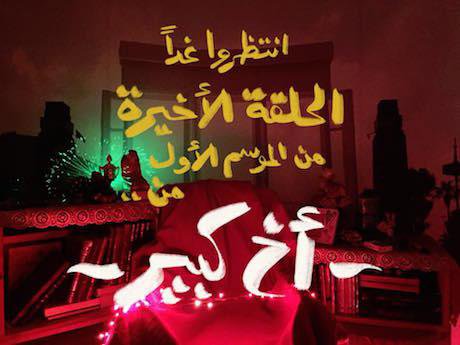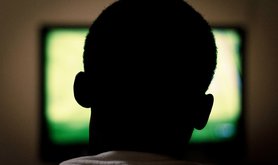
Big Brother. Mada MasrOn one of the many evenings when my Egyptian compatriots and I gather to watch sports, play PlayStation, and of course discuss politics, a close friend introduced me to a new satirical show on YouTube called “Big Brother”. This show is produced by Mada Masr, one of the few truly independent news outlets in Egypt.
Even though I am not a qualified critic, I was incredibly impressed by the short video clips and felt compelled to write and highlight the possible impact these videos as well as other forms of subversive art have on the ever-tightening grip of the Sisi regime. This is one of the few true forms of revolutionary art I have seen since the eruption of the mass protests in 2011.
The show revolves around the character of “Big Brother”, an anti-revolutionary man who analyses problems facing Egypt and offers solutions from a pro-regime perspective in a satirical manner. He provides a powerful critique of the regime using its own language and narrative.
The brilliance of the character is in his physical appearance, the language he uses and his physical gestures. The appearance of the character is that of the rural elite, one of the primary social groups supporting the regime. Big Brother has a moustache, is always carrying prayer beads, and walks around with his mobile phone.
The language he uses is obscene; he starts all the shows cursing at the audience, and the dialogue is filled with sexual and aggressive annotations. In essence, sharing the contempt the regime displays to the masses. The camera angle is low, allowing him to tower over the audience as he moves and gestures angrily imposing his authority.
This is combined with a brilliant set design, which has many symbols and hidden messages of subversion and resistance. For example, in the background one can see the eagle that occupies a prominent position on Egypt’s flag and is a potent symbol of the military regime that has ruled Egypt since 1952. However, directly next to it, we can see a picture of Mubarak with what appears to be clown make up on.
Next to this picture, one can see a toy with two balls that became known as the “Sisi testicles”. This toy was considered to be subversive enough to merit its confiscation from a number of street vendors as well as their arrest. One can also see the portrait of Mohamed Salah, a prolific footballer, who the regime has and probably still is attempting to co-opt.
In addition to the character of Big Brother, there is the character of the “Brown citizen”, to whom Big Brother directs his tirades and advice. This citizen fits the stereotype of your typical lower middle-class Egyptian who has been indoctrinated by years of autocracy into apathy and despair, and who accepts the ideology of the ruling elite as his own, without questioning. In other words, he becomes an obedient member of the repressed masses who also repress others.
In terms of content and topic, Big Brother offers a number of innovative solutions and views on the issues facing the Egyptian polity. One of my favourite episodes discusses the arts and television series that portray the struggles of middle class Egyptian women.
Big Brother offers unique insight into the role art and mass media play as tools for control, distraction and mass ideological indoctrination, as well as the close connection between the security apparatus and the cinema and entertainment industry.
He also highlights the fear the Egyptian middle class have of any forms of realistic art that portrays the actual practices of Egyptians and the reality of life, such as sexual practices and domestic violence.
Big Brother offers an innovative solution to the problem of realistic art, which is removing dialogue and replacing it with Quran. If the artist were to object, he would subject himself to public backlash and accusations of blasphemy, since he dared to remove the holy word of God from his art.
An age-old technique of using religious symbols to justify the repression of freedom of expression and thought. Big Brother, intelligently, exposes this process of decentralized repression where the citizenry themselves participate in stifling their fellow citizens.
Another memorable episode was “The Beginning of the End”, where Big Brother attempts to tackle the thorny issue of the presidential elections. The innovative solution he comes up with is for judgment day to occur, thus creating a distraction for the masses. But this strategy fails because the masses yearn for a strong leader who will provide deliverance from the horrors of judgment day. This is combined with a tirade against the people, as they should be grateful that their current leaders have agreed to rule them.
Once again, Big Brother exposes the inner workings of autocracy and how apocalyptic language is used to justify its existence, using fear of social disintegration as a way to justify its existence and to garner support.
Finally comes an episode where Big Brother tackles the complex issue of minorities in the broadest sense to include those that have different life styles or points of views. Big Brother highlights the function minorities play in autocratic regimes, where they allow members of the already repressed majority a sense of superiority and relief, since their level of repression is lower, comparatively speaking.
As such, Big Brother comes up with the innovative solution of creating a new category of minority, simply called “minority”. This category creates a sense of confusion within the ranks of the majority and increases their sense of superiority to the new minorities, which results in the majority then feeling oppressed, and a sense of despair seeps into their entire psyche. In essence, all Egyptians then become a minority.
To be fair, this is not a real critique, it is a rather a chance for me to say thank you to the staff of Mada Masr and Big Brother, who in spite of an unprecedented wave of repression remain a bastion of resistance, covering and producing material that is of both artistic and journalistic value.
One only needs to remember that Mada Masr remains blocked in Egypt since May 2017. It is also an acknowledgement that even though I felt alone, in reality, I am not. Resistance continues through any and all means necessary, and artists like the team behind Big Brother as well as musicians and bands like Cairokee are at its forefront.
Art achieves its highest purpose, in my opinion, when it questions the structures of power, oppression and control in society. A goal that Big Bother, among others achieve.
On a side note, the second season just started and I am looking forward to the renewed wisdom of Big Brother!
Read more
Get our weekly email




Comments
We encourage anyone to comment, please consult the oD commenting guidelines if you have any questions.